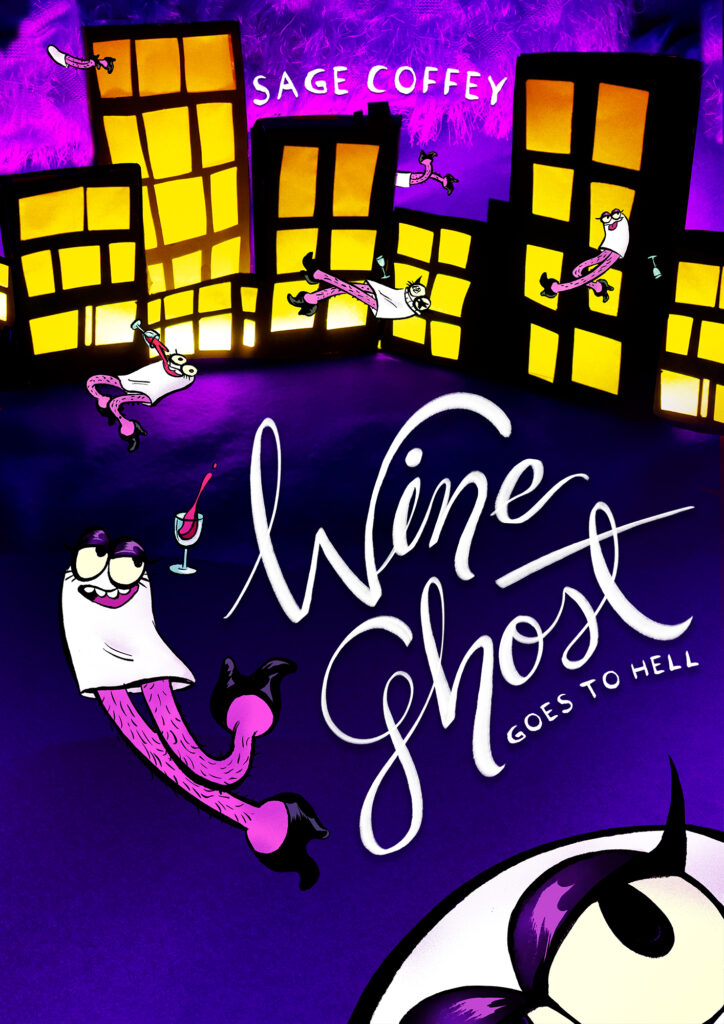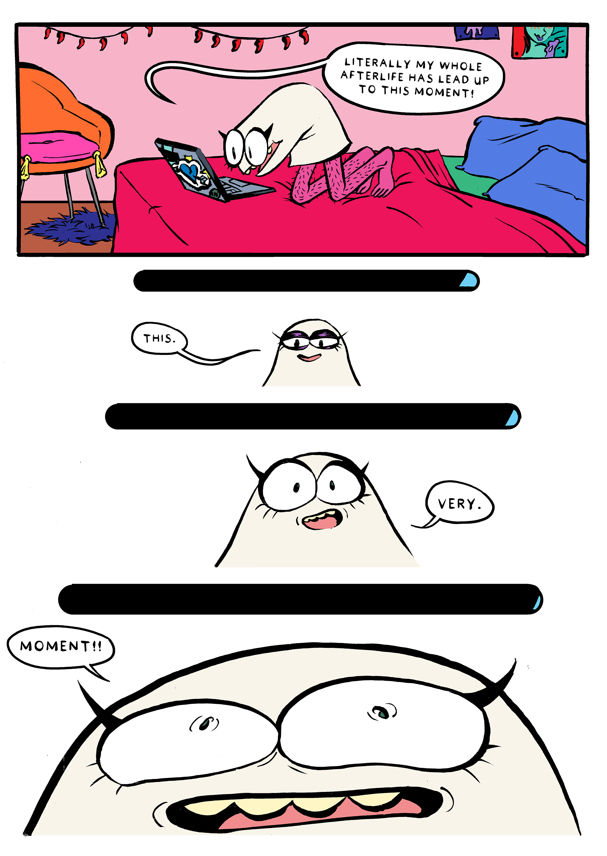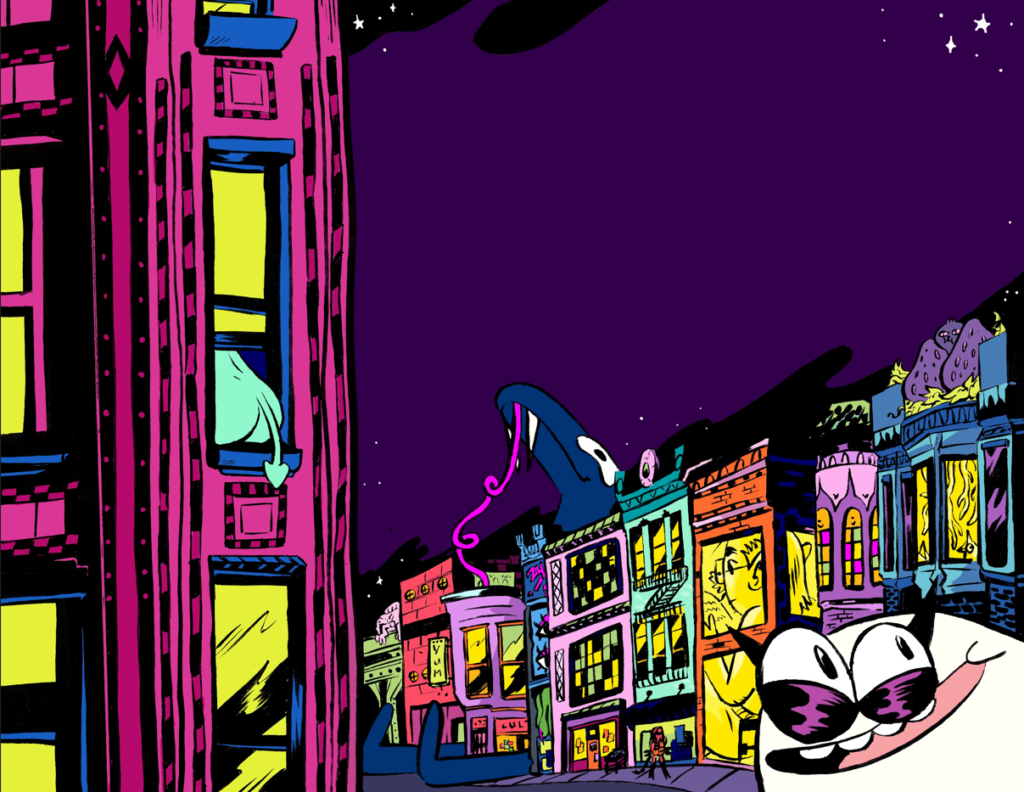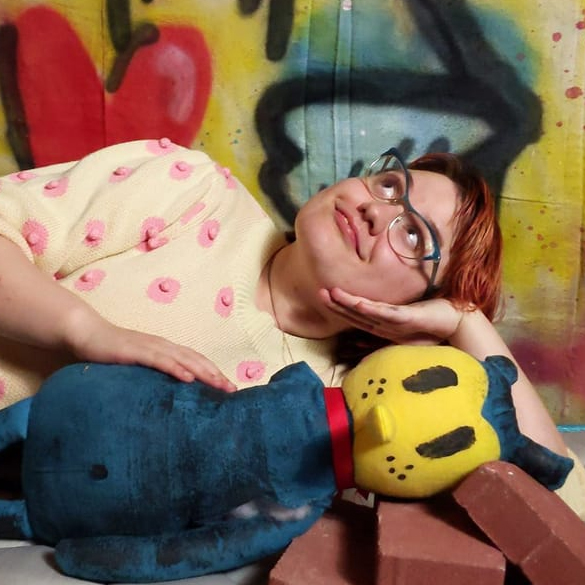Last updated on October 10, 2024
by Priya Saxena

Sage Coffey’s Wine Ghost Goes to Hell is a graphic novel following the (after)life of bizarre, ebullient Wine Ghost as she helps her newly deceased friend Sebastian settle into hell. Their search for an apartment leads them through the wildest and wackiest pockets of hell, populated by all manner of monsters. Wine Ghost is happy to help out a friend, but things aren’t quite as they seem, and Wine Ghost must face some hard truths about her past and her friendship with Sebastian in order to figure out what’s really going on. BoC had the opportunity to interview Sage Coffey about Wine Ghost Goes to Hell, out September 2023 from Iron Circus Comics.

I love Wine Ghost’s design. It’s so simple, yet so effective at conveying her personality. Once I saw her, I immediately wanted to learn more about her. What was your thought process in designing Wine Ghost? Did you know what her story was going to be before you designed her, or did that come later?
Oh, thank you! There was no thought process behind her design, haha. Wine Ghost actually started out as just a doodle in my sketchbook on a slow day at a show but the more I drew her, the more I got to know her as a character. Her story started to become clearer after I started drawing her in random scenarios like talking on the phone, eating chips with her feet. Now, I probably have a million Wine Ghost stories in me but her design definitely came first!
At first, this comic feels like it’s primarily lighthearted fun, with plenty of effective visual gags and a captivating vision of hell. But as the story progresses, we see that this fun exterior hides a darker core — a little like Wine Ghost herself, who is more complex than she might appear at first glance. How did you balance the humor with the more serious themes of the book?
Ultimately, Wine Ghost was a person before she was a ghost. I wanted Wine Ghost Goes to Hell to feel emotionally real despite how otherwise silly the book is. I can think of so many late night hangouts with pals where a vent session would turn into cracking jokes, and vice versa too. It’s an emotional balance we experience regularly, I think, so capturing that came down to pulling from memory.

Toward the end of the comic, there are staggering revelations dropped about Wine Ghost’s friend Sebastian and their history together. These revelations absolutely transform the story upon further readings. Moments that seemed innocuous before are thrown into an entirely different light. What sort of effect on the reader did you seek to accomplish by concealing this information for much of the story?
The situation with Sebastian was very much inspired by situations I’ve experienced and I wanted to portray that sheer sense of inner doubt with, if the reader decides to go through the book again, a later, hollow resolution to what happened. When you go through something like what Wine Ghost and Sebastian have, you comb through memories of that person looking for the warning signs and wondering what was real and what was fake. I want readers to question themselves, what they read through, and revisit Wine Ghost Goes to Hell to see all those little red flags planted every step of the way.
The story takes place in hell, but it doesn’t feel like any hell I’ve ever seen before in a comic. People are transformed into anthropomorphic or abstract creatures after death, and they still go to bars and shop for groceries and pay rent. It seems pretty similar to the living world, only everybody is a cool monster. How did you decide what hell would be like for this story, and why set it in hell or the afterlife at all?
I really like the juxtaposition of very real situations in an otherwise wacky world! I figured the concept of life after death has been around as long as we have, so it made sense to me that the afterlife had progressed at the same time as the living. People would adapt to their own unique bodily forms in the afterlife but otherwise I think they’d default to what was comfortable to them in their living days. Almost like Romero’s zombies with their personalities still intact.

When Wine Ghost is introduced at the beginning of the book, she’s presented in a way that invites us to judge her. But you depict her with care and affection throughout the story, and by the end we’ve seen that she’s much more than her hot mess exterior. What do you love about Wine Ghost? What is it about her that you think resonates with readers?
I believe the reason she resonates with others is exactly the reason why I love Wine Ghost as a character too; Wine Ghost is unafraid of who she is and expresses herself without fear of judgment. She’s confident and she’s loved even when she’s drunk, depressed or otherwise messy! I also think, maybe tangentially, that in a society where femmes are taught to minimize themselves, seeing a femme character take up so much space with her big personality without the weight of good representation hanging over her is probably refreshing too. Also, I just really love drawing her noodley legs!

Sage Coffey is a trans non-binary cartoonist living in Chicago, IL. They graduated from SCAD Atlanta with a Bachelor’s in Sequential art and Animation in 2015. Since 2016 they’ve edited the Ignatz award nominated anthology Sweaty Palms, a comic anthology about anxiety and have helped organize Chicago Alternative Comics Expo (CAKE) since 2019.
Sage has been published by The New Yorker, The Washington Post, The Nib, and multiple award winning comics anthologies such as Comics for Choice and Be Gay, Do Comics. They’ve also worked freelance work for Cards Against Humanity, Def Jam Entertainment, Millie Magazine, Young Horses Games, WeTestify, The Chicago Public Library and Kickstarter LLC.
Sage was a 2018 and 2019 John Locher award honorable mention as well as a 2021 GLAAD Award Nominee for their work on BUGSNAX (nominated for Best Video Game). Illustrator on one of Vulture’s Best Comedy Books of 2021, I AM NOT A WOLF.
Priya Saxena (she/her or they/them) is a writer and critic based in New York City who enjoys reading queer comics and watching campy television. You can follow them on Twitter at @lettersofpriya.
